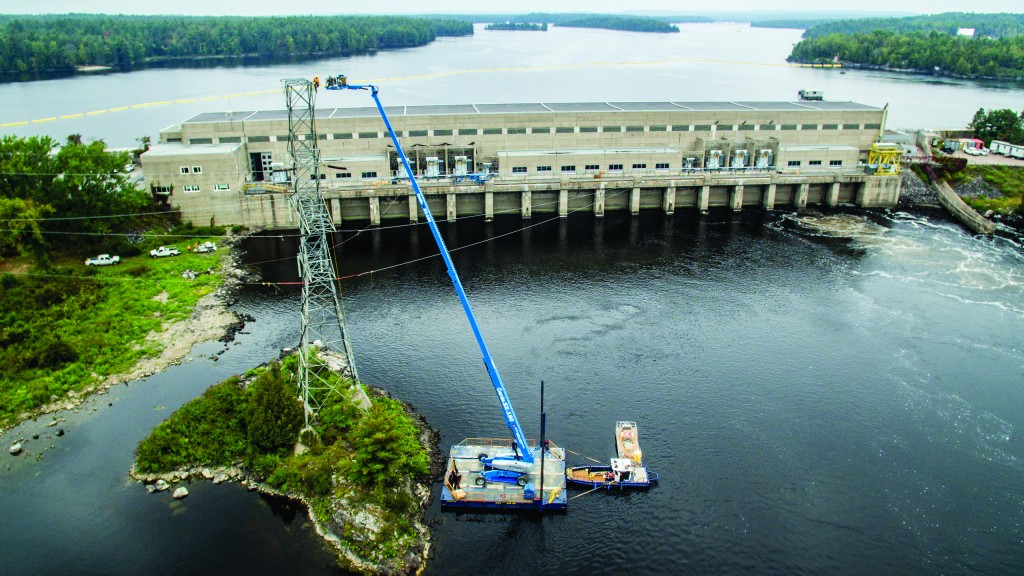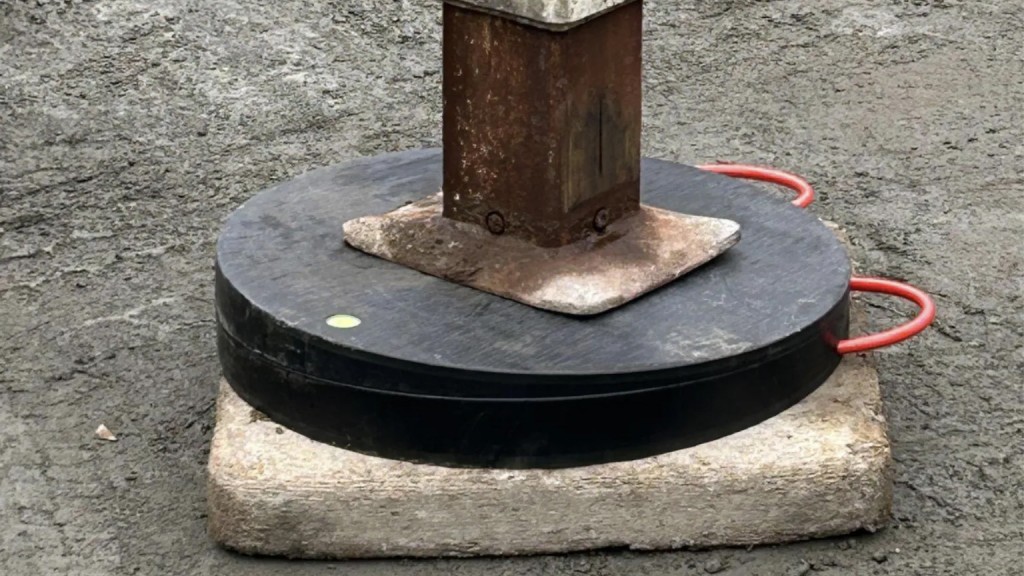Genie telescopic boom generates electrified performance for Ottawa River powerline replacement
O.D.S. Marine uses Genie SX-180 telescopic boom operated from a barge

The Chenaux Generating Station located on the Ottawa River in Ontario uses the river's current to generate 144 MW of clean, renewable electricity, enough to power nearly 150,000 homes on the grid. Like other hydro-electric power structures, its eight units were built in the mid-twentieth century as a stimulus project to help the country shake off the effects of the Great Depression.
Also like other structures built during this era, regular maintenance to the dam structure, power units and lines is required to keep it operating at maximum capacity. These types of maintenance projects help the bottom line of companies like Ottawa, Ontario's, O.D.S. Marine. "In addition to our construction-related services, we do underwater video inspections and core sampling, bottom surveys, dam maintenance, grouting/concrete work, and demolition," says Ken Rule, operations manager for O.D.S. Marine.
When the time came for line replacement at the Chenaux Generating Station, O.D.S. Marine's 36 years of experience made the company the right choice to devise the best way to get powerline workers access to the first line tower, which is located in the water. They provided a time-saving and cost-effective solution using stick boom equipment to safely run new powerlines from a barge.
Finding the right solution to overcome difficult access to the tower
"The tower's lines reached 130 feet (39.6 m) above of the waterline, which made it difficult for the workers to access," recalls Nathan Russell, sales representative for Ontario Rental and Supply (ORS) of Ottawa, Ontario, an equipment distributor that rents Genie aerial work platforms. "It was extremely challenging for workers and the necessary maintenance equipment to get to line height, since safety standards are stringent on dam projects and OPG [Ontario Power Generation, dam owner] standards are even higher."
There were a number of options O.D.S. Marine could have considered to attack the powerline replacement project. They ranged from the expensive, such as a helicopter or crane plus man basket for access, to the entirely manual option of workers climbing the tower, but that would take extra time and labour, plus it would increase risk to the workers.
Rule and Jim Freeth, general manager for O.D.S. Marine, considered another option that involved the use of a stick boom positioned on a sectional barge to offer access to the tower. "The powerline work required an IMO (Independent Market Operator) permit to shut down multiple power generating stations while work was being completed, which costs the maintenance contractor money," comments Rule. "Therefore, we had to come up with an equipment solution that would allow workers to quickly get the job done."
While the tower was located on an island, Rule reports the terrain was too rocky and uneven for a crane or stick boom to safely walk off the barge to complete the work. He consulted with Russell at ORS to provide a rental equipment solution for accessing the lines. "Knowing the working height requirements and that the machine would be positioned on a barge, we recommended the Genie SX-180 telescopic boom, which offers a 180-foot [54.9-m] maximum platform height and maximum horizontal reach of 80 feet [24.4 m]," recalls Russel.
O.D.S. Marine took information received from ORS and ran calculations to ensure the boom could safely work from the barge. "It's critical to hire a company like O.D.S. Marine, who has marine professionals on staff to thoroughly analyze what is required for a solution to safely and efficiently perform the work," explains Rule.
Using a telescopic boom on a barge required special considerations
O.D.S. Marine also worked with Genie representatives during the Genie SX-180 boom evaluation process to determine what special considerations must be met. "We have been operating Genie booms from barges since the mid-1990s," says Rule, "but they are typically in the 60- to 125-foot (18.3- to 38.1-m) size range. We like using Genie equipment because they are operator friendly and don't require an operating engineer like with crane equipment. If we were to use a crane for this application, it would increase the crew by at least one person, which is an additional expense."
Company representatives were assured that the 55,000-pound (24,948-kg) telescopic boom could be operated from the barge, but there were some special operating parameters that must be met. "The first requirement," offers Sean Larin, Genie product safety manager, Terex AWP, "is for the company to get a guidance letter. We require that Genie (or a Genie representative) be contacted directly to get the letter. This outlines the parameters for working the equipment from a barge, and the company must keep a printed copy of the letter inside the waterproof manual storage compartment."
O.D.S. Marine had to ensure the Genie SX-180 boom stayed to within two degrees of level at all times, and that the barge could handle the weight. "During the project, generators one through six were temporarily shut down to help slow the current," says Rule. "We determined that using four barge sections gave us the capacity and stability we needed to operate the Genie SX-180 boom. Barge size was 34 x 45 feet [10.4 x 12.7 m] with a depth of 4 feet [1.2 m]."
Once positioned on the barge, the machine can no longer be driven. All the movement that would normally be made through the drive system must be made via barge movement. "The contractor just needs to anchor the boom to the barge using chains secured to the machine's normal tie-down locations, and the tires need to be chocked," says Larin.
The barge must also be anchored to land or a boat to simulate ground conditions during windy and/or wavy water conditions. "We used a hydraulic spud anchoring system with the sectional barges," comments Rule. "If we were to use a jack-up barge, mobilization/demobilization costs would have been substantially higher than the solution we presented. Most jack-ups are transported by water only, and this was not a viable option."
Variety of work tools and equipment made the job easier
With all the calculations complete and necessary paperwork in place, O.D.S. Marine connected four of the Bentley Series barge sections to achieve the planned barge dimensions for accommodating the Genie SX-180 boom. The machine was secured to the barge deck using the tie-downs, and the barge and boom were anchored just off the edge of the jetty stone island to steady the barge and boom during operation.
A tugboat transported a work crew of four – two for the tower and two marine support workers – from the main shoreline to the barge and back. The line replacement plan included using the old powerlines to pull the new lines from the dam-mounted transformer to Tower 1 in the river and then onto the next land-based tower.
The tower crew needed a variety of work tools and equipment during this operation. "Among other equipment, the Genie SX-180 boom moved new insulators, swaging equipment, line pull equipment and pulley blocks," recalls Rule. Stephane Riggi, Genie regional sales manager, Terex AWP, adds, "The Genie SX-180 boom includes a standard 8-foot (2.4-m) platform and a lift capacity of 750 pounds (340 kg), so it easily accommodates two workers plus work equipment."
While installing more than 10 new high-voltage powerlines, workers took advantage of the boom's standard jib to move them into position on the tower, since machine movements were restricted to movements made by the barge. "Along with the Genie SX-180 boom's turntable offering 360-degree continuous rotation," mentions Riggi, "the jib offers 135-degree vertical and 60-degree horizontal rotation, plus the platform rotates 160 degrees."
Rule adds, "The workers really benefitted from the jib and platform rotation to move them around to different locations on the tower, since machine movements were limited. We only had to move the barge four times to replace all the powerlines."
O.D.S. Marine's plan to use the Bentley Series sectional barge with Genie SX-180 telescopic boom saved significant time and money for all parties involved. Rule explains that the project was estimated to take three weeks to finish. It was completed in just two, saving a third of the time. If the company would have moved up to a jack-up barge, estimates for mobilization/demobilization would have reached as high as $500,000 for the job. As it was completed by using the sectional barges, total barge and equipment costs tallied only $100,000.
"It was very cost effective to use the equipment as we specified," comments Rule. "The Genie SX-180 boom operated within all parameters and enabled the job to be finished quickly. The machine performed perfectly and the job came off without a flaw. The planned outage was completed ahead of schedule, so everyone walked away from the project happy."



